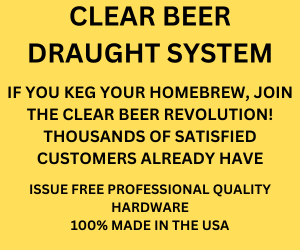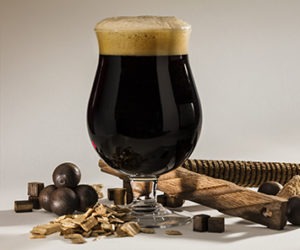Brewing with Maple: Tips from the Pros
Nothing says spring in the Northeast, Upper Midwest, and Canada like the sight of smoke and steam rising from sugar shacks. Many automatically envision drizzling the sweet maple syrup being boiled down on pancakes, but it doesn’t all have to be destined for your breakfast plate. How about using it to brew? No matter where you live, maple syrup can be included in your lineup of brewing ingredients.
Brewer: Jon Cadoux, Peak Organic Brewing Co. in Portland, ME
We brew an amber ale called Maple Collaboration every year as a fall seasonal release. This beer has two maple syrup additions — one near the end of the boil and another during conditioning. The first addition is intended to give it a firm maple foundation, but as with most hot side additives it loses some of the bright maple characteristics through the boil and as the sugars are eaten during fermentation. Still, it lays a nice maple foundation that we really dig. Additions during the boil will also boost alcohol, however that is not the intention in that addition, for us. On the cold side, after fermentation, is where we get a lot of the bright, snappy maple character through that second addition.
This recipe has evolved over the years and every year the amount of maple we add varies a little bit because the syrup is different from year to year. It isn’t like Aunt Jemima where the product is always the same, this is true maple syrup we get from Butternut Farm in Vermont, and the quality and characteristics are representative of the year and spring conditions. We always use what used to be called “grade B” maple syrup, which is one of the darkest syrups. When we developed this recipe we tried lots of different grades in test batches and grade B blended best with the beer — it was the clear winner.
We use a different base amber ale style recipe for Maple Collaboration than our Amber Ale we brew, in part because we want a little more malt character and body, which comes from a larger addition of oats. Our Amber Ale is 4.9% ABV, while Maple Collaboration comes in around 7%. We found over time that you need a little bit more body in the beer to create a solid foundation for the maple flavor that we were looking for; otherwise it ends up tasting too thin. That’s probably why most beers with maple are stouts and porters, but we wanted to do something different because: A, that’s been done, and B, we thought there was a little too much competition between the dark malts and the maple syrup, so we went with a more easy-drinking amber ale.
How you use maple probably depends on your brewing philosophy. The way we design our beers is always looking at one, maybe two at the most, flavors to shine. We figure out what we want the top note of a beer to be and design the rest of the recipe to showcase that. With this beer, maple is the ingredient we want to shine.
When brewing with maple syrup, the best advice I can give is not to be afraid of post-fermentation additions, but make sure you really give your fermentation time. You want to be sure fermentation really is complete by the time you add maple. Obviously there is no scarier thing than throwing a bunch of sugar into a beer and packaging it when the yeast is still rocking. Get it to terminal gravity and then give it a couple more days before adding the maple syrup.
Brewer: Matt Stewart, The Argyle Brewing Company, in Greenwich, NY
Chris began making maple porter using maple syrup in 1989 and continued until 1999. The results were good (a little more sweet) and friends and family really liked it. However, when he started tapping his own trees and boiling the sap down to syrup, he had an “aha” moment. He realized he was wasting energy by reducing sap only to reconstitute it. In 2000, he started to play with reduction; reducing it only to the ideal taste point. Today, brewing water is replaced with sap to brew Double Tap Maple Porter throughout the entire process, even in the sparging. They like to say, “All sap, no tap!”
The goal is to reduce the sap to capture the sweetness of the maple without boiling out the earthy tones. Chris starts with about a 50% reduction — meaning if you are making a 5-gallon (19-L) batch you would need to start with 10 gallons (38 L) of sap. If it’s too sweet once you do that then add some raw sap, if it’s not sweet enough keep boiling it down. Instead of using gravity points, Chris lets the taste guide the decision of how much to reduce since the taste differs each year. Homebrewers wishing to replicate this style should use the reduced sap as soon as the taste point is reached. If it sits around too long, the sap may pick up some unwanted, funky flavors.
When it comes to choosing a base style for a maple beer, porter happens to be one of Chris’ favorite styles, so cathat is where he started, but maple can be used with many base beer styles. Matt has made some awesome maple wheat and Argyle Brewing Co. has used maple syrup in several recipes to give it maple flavor. Like all styles, it is a matter of personal taste. No matter the style, the maple should be the star of the show — but any good beer needs to be well balanced. Brewers can play with the hops they like and then start the balancing game.
Anyone can brew with syrup, but for homebrewers who live where the maple flows, try tapping your trees (or your neighbors’ trees), fire up the burners, kick your feet up, have a homebrew and enjoy the view.
Brewer: Karl Schmitz, Third Street Brewhouse in Cold Spring, MN
To brew Sugar Shack we add maple syrup after the beer is done fermenting and is cool to prevent any refermentation. Obviously since we are doing a post-fermentation addition we use syrup instead of sap since it is a much more concentrated flavor. The usage rate is pretty low. I won’t say exactly what it is, but I will say it’s less than 1% by volume. We use high-quality maple syrup harvested at the Saint John’s Abbey Arboretum and Forest in Collegeville, Minnesota. Like anything else, the quality of the end flavor will depend on the quality of ingredients you use.
Our goal is to have a nice maple syrup flavor that doesn’t overpower the rest of the beer, and we find that adding maple syrup after the beer has been cooled retains the maple flavor well. It’s important to note that within a day of adding the syrup we centrifuge the beer and remove the yeast so that it can’t referment. The bottles are also pasteurized, but not the kegs. The best option to avoid re-fermentation on a homebrew level would be to keep the beer cold until you are ready to drink it. As long as it is stored well below the fermentation temperature of the yeast, the beer will not referment.
Sugar Shack is a sweet stout and in this case some of the sweetness is just coming from the maple syrup. The addition of maple does not affect our selection of other ingredients — we use the same grains, hops, and yeast that we would for a sweet stout without maple.
This is just the way we do it with this specific beer. Don’t be afraid to play around with maple additions in other styles or do something crazy. That’s part of the fun!



